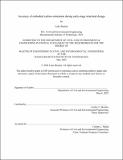Accuracy of embodied carbon estimation during early-stage structural design
Author(s)
Bastian, Luke
DownloadThesis PDF (3.395Mb)
Advisor
Mueller, Caitlin T.
Terms of use
Metadata
Show full item recordAbstract
The embodied carbon of the built environment accounts for approximately 11% of the planet’s annual carbon emissions and is projected to increase significantly as an additional 2.5 billion people are expected to be living in cities by 2050. In recent years, a number of tools have been developed to predict carbon emissions associated with buildings. However, due to these tools being either overly simplistic or contingent on exact material quantities being known, very few can be effectively used to inform structural design decisions. It is then essential that strategies are developed to better estimate and reduce embodied carbon early in the design process.
This work explores the ability of an improved building model generator to predict the embodied carbon stemming from structural members, specifically floors, beams, columns, foundations, and structural walls. The generated models can take the shape of any building outline - no matter how complex - and allow designers to adjust important design parameters including column spacing, beam spacing, loading, materiality, and more. Regarding materials, designers can explore tradeoffs between timber, steel, and concrete framed structures (or combinations of two). Building information models (BIMs) of four existing structures are then utilized as ground truths for validation of these models, which are found to be relatively predictive of actual embodied carbon with a maximum error of 10%. While the speed of the model needs some improvement, this work demonstrates that it can be accurately used in early design stages to predict embodied carbon and adjust designs accordingly.
Date issued
2022-05Department
Massachusetts Institute of Technology. Department of Civil and Environmental EngineeringPublisher
Massachusetts Institute of Technology